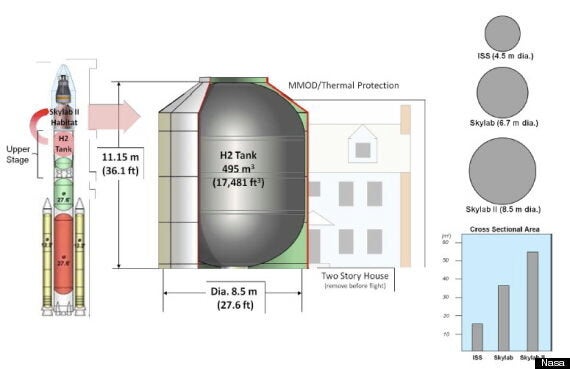Only rarely has Nasa had the budget to meet its ambitions.
When it doesn't? That's when it gets creative.
The US space agency is currently looking to develop the first permanent home for humans in deep space.
Unfortunately outright funding for such a mammoth project are a little hard to come by, so instead Nasa might have a better idea - "embed" the project in something they do have funding for, and hope nobody minds.
According to a profile of a Nasa engineer over at Space.com, an upper-stage hydrogen propellant tank in its next-generation 'mega rocket' -- the Space Launch System -- could be used as a space station module.
A space station module the size of a house.
The idea relies on the sheer scale of the new rocket, which is being built to launch astronauts back to the Moon - and on to near-Earth asteroids and possibly even Mars.
Scheduled for a test launch in 2017, the SLS stands 384-feet tall and can blast 130 tons of payload into orbit.
The upper-stage hydrogen tank alone is the size of a two-storey house - about 17,500 cubic feet. That's much bigger than the modules on the International Space Station, which are just 15 feet wide, and means that a module launching aboard the SLS could be built out of a single gas tank - and could be launched relatively cheaply.

Above: how the gas-tank space station might work
Brand Griffin, an engineer with Gray Research, Inc who works with Nasa's Advanced Concepts Office, told Space.com that the idea "is not challenging technology".
Referring to the potential deep-space module as "Skylab II", the idea could make a deep space craft feasible even in a time of constrained budgets.
The name derives from the original Skylab project, which used parts of the Saturn V rocket to build an early space station at a time of declining budgets, after the Apollo mission ended.
"It could be a project embedded under SLS and be able to, ideally, not incur some of the costs of program startup," he said.
"We will have the facilities in place, the tooling, the personnel, all the supply chain and everything else."
The gas tank space station would make it possible to build multiple outposts, and ferry astronauts between then, Griffin added. A crew of four could live comfortably aboard each module, he estimates.
"If we were to send this one, the first one, out to Earth-moon L2, you could build another that that could be a transit hub. So rather than having to go back and use space station parts, you would be able to pick these off the line."
Read the full post over at Space.com.